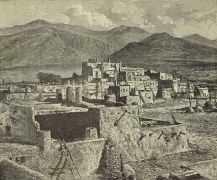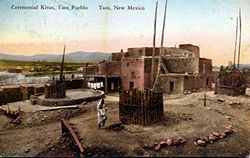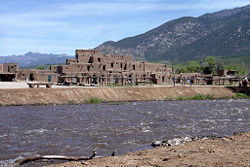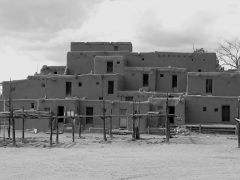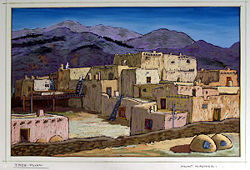Taos Pueblo
| Taos (t’óynemą) |
|---|
| Total population |
| 1,000 (1990 census) |
| Regions with significant populations |
| United States (New Mexico) |
| Languages |
| Taos, English, Spanish |
| Religions |
| Taos religion, Christianity |
| Related ethnic groups |
| other Kiowa-Tanoan peoples |
| Taos Pueblo | |
|---|---|
| (U.S. National Historic Landmark District) | |
| | |
| Nearest city: | Taos, New Mexico |
| Added to NRHP: | October 15, 1966 |
| Reference #: | 66000496 [1] |
| Governing body: | Native American tribal government |
| Pueblo de Taos* | |
|---|---|
| UNESCO World Heritage Site | |
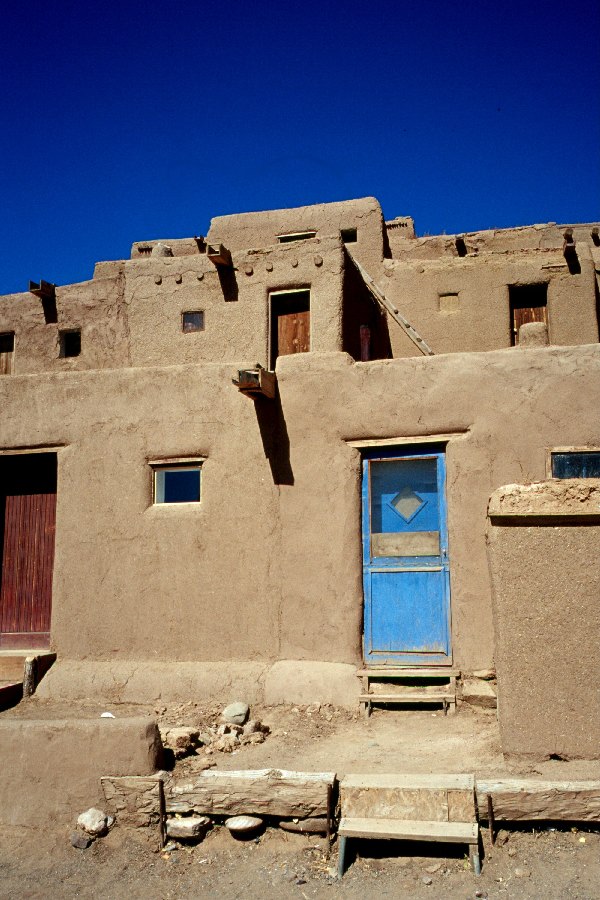
| |
| State Party | |
| Type | Cultural |
| Criteria | iv |
| Reference | 492 |
| Region** | Europe and North America |
| Inscription history | |
| Inscription | 1992 (16th Session) |
| * Name as inscribed on World Heritage List. ** Region as classified by UNESCO. | |
Taos Pueblo (or Pueblo de Taos) is an ancient pueblo belonging to a Taos (Northern Tiwa) speaking Native American tribe of Pueblo people. It is approximately 1000 years old and lies about 1 mile (1.6 km) north of the modern city of Taos, New Mexico, USA. The Red Willow Creek, or Rio Pueblo, is a small stream which flows through the middle of the pueblo from its source in the Sangre de Cristo Range. A reservation of 95,000 acres (384 km²) is attached to the pueblo, and about 1,900 people live in this area[2].
Taos Pueblo is a member of the Eight Northern Pueblos. The Taos community is known for being one of the most secretive and conservative pueblos.
Taos Pueblo's most prominent architectural feature is a multi-storied residential complex of reddish-brown adobe divided into two parts by the Rio Pueblo. According to the Pueblo's Web site, it was probably built between 1000 and 1450 C.E. It was designated a National Historic Landmark on October 9, 1960, and in 1992 became a World Heritage Site. As of 2006, about 150 people live in it full-time[3].
Name
In the Taos language, the pueblo is referred to as "the village" in either tə̂otho "in the village" (tə̂o- "village" + -tho "in") or tə̂obo "to/toward the village" (tə̂o- "village" + -bo "to, toward"). The proper name of the pueblo is ȉałopháymųp’ȍhə́othə̀olbo "at red willow canyon mouth" (or ȉałopháybo "at the red willows" for short); however, this name is more commonly used in ceremonial contexts and is less common in everyday speech.
The name Taos in English was borrowed from Spanish Taos. Spanish Taos is probably a borrowing of Taos tə̂o- "village" which was heard as tao to which the plural -s was added although in the modern language Taos is no longer a plural noun. The idea that Spanish Taos is from tao "cross of the order of San Juan de los Cabelleros" (from Greek tau) is unlikely.[4]
Prehistory and history
Most archeologists believe that the Taos Indians along with other Pueblo Indians settled along the Rio Grande migrated from the Four Corners region. The dwellings of that region were inhabited by the Anasazi, and a long drought in the area in the late 1200s, may have caused them to move to the Rio Grande where the water supply was more dependable.
The history of Taos Pueblo include the plotting of the Pueblo Revolt in 1680, a siege by U.S. forces in 1847, and the return by President Nixon in 1970 of the Pueblo's 48,000 acres (194 km²) of mountain land taken by President Theodore Roosevelt and designated as the Carson National Forest early in the twentieth century.[5] Blue Lake, which the people of the Pueblo traditionally consider sacred, was included in this return of Taos land. The Pueblo's web site names the acquisition of the sacred Blue Lake as the most important event in its history due to the spiritual belief that the Taos natives originated from the lake itself. An additional 764 acres south of the ridge between Simpson Peak and Old Mike Peak and west of Blue Lake were transferred back to the Pueblo in 1996.[6]
Structure
The North-Side Pueblo is said to be one of the most photographed and painted buildings in the Western Hemisphere. It is the largest multistoried Pueblo structure still existing. It is made of adobe walls that are often several feet thick. Its primary purpose was for defense. Up to as late as 1900, access to the rooms on lower floors was by ladders on the outside to the roof, and then down an inside ladder. In case of an attack, outside ladders could easily be pulled up.
The homes in this structure usually consist of two rooms, one of which is for general living and sleeping, and the second of which is for cooking, eating, and storage. Each home is self-contained; there are no passageways between the houses. Taos Indians made little use of furniture in the past, but today they have tables, chairs, and beds. In the Pueblo, electricity, running water, and indoor plumbing are prohibited.
The pueblo wall completely encloses the village except at the entrance as a symbol of the village boundaries. Now rather short, the wall used to be much taller for protection against surrounding tribes. The river running through the pueblo serves as the primary source for drinking and cooking water for the residents of the village. In the winter, the river never completely freezes although it does form a heavy layer of ice. Because the river moves so swiftly, the ice can be broken to obtain the fresh water beneath.
Spiritual community
Three religions are represented in the Pueblo: Christianity, the aboriginal religion, and the Native American Church. Most of the Indians are Roman Catholic. Saint Jerome, or San Geronimo, is the patron saint of the pueblo....
The deep feeling of belonging to a community, summed up in their phrase, “we are in one nest,” has held the Taos people together. Both men and women are expected to offer their services or “community duties,” when needed. One should be cooperative and never allow their own desires to be destructive of the community’s interest. One of Taos’s strongest institutions is the family. Descent on both the father and the mother’s side of the family is equally recognized. Each primary family lives in a separate dwelling so when a couple gets married, they move to their own home. With relatives so near by, everyone is available to help care for the children. The elderly teach the young the values and traditions that have been handed down, which protects the integrity of the Taos culture.
Additional images
- Taos Pueblo
Taos Pueblo Church (1942) by Ansel Adams
Notes
- ↑ National Register Information System. National Register of Historic Places. National Park Service (2006-03-15).
- ↑ Who lives in the Pueblo? (scroll down)
- ↑ Who lives in the Pueblo? (scroll down)
- ↑ Jones, William. (1960). Origin of the place name Taos. Anthropological Linguistics, 2 (3), 2-4; Trager, George L. (1960). The name of Taos, New Mexico. Anthropological Linguistics, 2 (3), 5-6.
- ↑ Julyan, B: New Mexico's Wilderness Areas: The Complete Guide, page 73. Big Earth Publishing, 1999
- ↑ Public Law 104-333 (PDF). Retrieved 2008-07-19.
ReferencesISBN links support NWE through referral fees
- Bodine, John J. 1977. Taos Pueblo: a walk through time : a visitor's guide to the pueblo, its people, and their customs and their long history. Santa Fe, N.M.: Lightning Tree. ISBN 9780890160381
- Keegan, Marcia. 1991. The Taos Pueblo and its sacred Blue Lake. Santa Fe, N.M.: Clear Light Publishers. ISBN 9780940666122
- National Park Service. Taos Pueblo Retrieved December 16, 2008.
- TaosWebb. Taos Pueblo - A thousand years of tradition Retrieved December 16, 2008.
- Wood, Nancy C. 1989. Taos pueblo. New York: Knopf. ISBN 9780394560328
External links
All Links Retrieved December 16, 2008.
- Webcam of sacred Taos Mountain
- Maps and aerial photos
- Street map from Google Maps or Yahoo! Maps
- Topographic map from TopoZone
- Satellite image from Google Maps or Microsoft Virtual Earth
Cahokia | Carlsbad Caverns | Chaco Culture | Everglades | Grand Canyon | Great Smoky Mountains | Hawaii Volcanoes | Independence Hall | Kluane / Wrangell-St. Elias / Glacier Bay / Tatshenshini-Alsek (w/ Canada) | La Fortaleza and San Juan National Historic Site, Puerto Rico | Mammoth Cave | Mesa Verde | Monticello and University of Virginia | Olympic | Pueblo de Taos | Redwood | Statue of Liberty | Waterton Glacier International Peace Park (w/ Canada) | Yellowstone | Yosemite
Credits
New World Encyclopedia writers and editors rewrote and completed the Wikipedia article in accordance with New World Encyclopedia standards. This article abides by terms of the Creative Commons CC-by-sa 3.0 License (CC-by-sa), which may be used and disseminated with proper attribution. Credit is due under the terms of this license that can reference both the New World Encyclopedia contributors and the selfless volunteer contributors of the Wikimedia Foundation. To cite this article click here for a list of acceptable citing formats.The history of earlier contributions by wikipedians is accessible to researchers here:
The history of this article since it was imported to New World Encyclopedia:
Note: Some restrictions may apply to use of individual images which are separately licensed.
